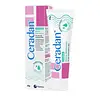What's inside
What's inside
 Key Ingredients
Key Ingredients

 Benefits
Benefits

 Concerns
Concerns

 Ingredients Side-by-side
Ingredients Side-by-side

Water
Skin ConditioningButylene Glycol
HumectantOlea Europaea Fruit Oil
MaskingSqualane
EmollientPentylene Glycol
Skin ConditioningPolysorbate 60
EmulsifyingStearic Acid
CleansingGlyceryl Stearate
EmollientPropylene Glycol Stearate
Skin ConditioningCetyl Palmitate
EmollientLeuconostoc/Radish Root Ferment Filtrate
AntimicrobialPhenoxyethanol
PreservativeSorbitan Stearate
EmulsifyingCarbomer
Emulsion StabilisingPotassium Hydroxide
BufferingTocopherol
AntioxidantSodium Hyaluronate
HumectantRoyal Jelly Extract
Skin ConditioningPanax Ginseng Root Extract
EmollientWater, Butylene Glycol, Olea Europaea Fruit Oil, Squalane, Pentylene Glycol, Polysorbate 60, Stearic Acid, Glyceryl Stearate, Propylene Glycol Stearate, Cetyl Palmitate, Leuconostoc/Radish Root Ferment Filtrate, Phenoxyethanol, Sorbitan Stearate, Carbomer, Potassium Hydroxide, Tocopherol, Sodium Hyaluronate, Royal Jelly Extract, Panax Ginseng Root Extract
Water
Skin ConditioningHydrogenated Polydecene
EmollientSimmondsia Chinensis Seed Oil
EmollientButylene Glycol
HumectantCyclopentasiloxane
EmollientGlycerin
HumectantBehenyl Alcohol
EmollientGlyceryl Stearate
EmollientPEG-60 Glyceryl Isostearate
Cetyl Alcohol
EmollientPentylene Glycol
Skin ConditioningTrideceth-12
EmulsifyingSodium Lauroyl Lactylate
EmulsifyingSorbitan Stearate
EmulsifyingBeeswax
Emulsion StabilisingDimethicone
EmollientPEG-32
HumectantPEG-6
HumectantHydroxypropyl Bispalmitamide Mea
EmollientPhenoxyethanol
PreservativeCarbomer
Emulsion StabilisingEthylhexylglycerin
Skin ConditioningCholesterol
EmollientLinoleic Acid
CleansingTocopherol
AntioxidantXanthan Gum
EmulsifyingSodium Hyaluronate
HumectantSodium Hydroxide
BufferingWater, Hydrogenated Polydecene, Simmondsia Chinensis Seed Oil, Butylene Glycol, Cyclopentasiloxane, Glycerin, Behenyl Alcohol, Glyceryl Stearate, PEG-60 Glyceryl Isostearate, Cetyl Alcohol, Pentylene Glycol, Trideceth-12, Sodium Lauroyl Lactylate, Sorbitan Stearate, Beeswax, Dimethicone, PEG-32, PEG-6, Hydroxypropyl Bispalmitamide Mea, Phenoxyethanol, Carbomer, Ethylhexylglycerin, Cholesterol, Linoleic Acid, Tocopherol, Xanthan Gum, Sodium Hyaluronate, Sodium Hydroxide
Ingredients Explained
These ingredients are found in both products.
Ingredients higher up in an ingredient list are typically present in a larger amount.
Butylene Glycol (or BG) is used within cosmetic products for a few different reasons:
Overall, Butylene Glycol is a safe and well-rounded ingredient that works well with other ingredients.
Though this ingredient works well with most skin types, some people with sensitive skin may experience a reaction such as allergic rashes, closed comedones, or itchiness.
Learn more about Butylene GlycolCarbomer is a polymer of acrylic acid. Its main role is to create a gel consistency.
A high amount of carbomer can cause pilling or balling up of products. Don't worry, most products contain 1% or less of carbomer.
Glyceryl Stearate is a mix of glycerin and stearic acid.
It is used to stabilize the mixing of water and oil ingredients. By preventing these ingredients from separating, it can help elongate shelf life. It can also help thicken the product's texture.
As an emollient, it helps soften skin and supports barrier-replenishing ingredients.
In cosmetics, Glyceryl Stearate is often made from vegetable oils or synthetically produced.
This ingredient may not be fungal-acne safe
Fun fact: The human body also creates Glyceryl Stearate naturally.
Learn more about Glyceryl StearatePentylene glycol is typically used within a product to thicken it. It also adds a smooth, soft, and moisturizing feel to the product. It is naturally found in plants such as sugar beets.
The hydrophilic trait of Pentylene Glycol makes it a humectant. As a humectant, Pentylene Glycol helps draw moisture from the air to your skin. This can help keep your skin hydrated.
This property also makes Pentylene Glycol a great texture enhancer. It can also help thicken or stabilize a product.
Pentylene Glycol also acts as a mild preservative and helps to keep a product microbe-free.
Some people may experience mild eye and skin irritation from Pentylene Glycol. We always recommend speaking with a professional about using this ingredient in your routine.
Pentylene Glycol has a low molecular weight and is part of the 1,2-glycol family.
Learn more about Pentylene GlycolPhenoxyethanol is a preservative that has germicide, antimicrobial, and aromatic properties. Studies show that phenoxyethanol can prevent microbial growth. By itself, it has a scent that is similar to that of a rose.
It's often used in formulations along with Caprylyl Glycol to preserve the shelf life of products.
Sodium Hyaluronate is hyaluronic acid's salt form. It is commonly derived from the sodium salt of hyaluronic acid.
Like hyaluronic acid, it is great at holding water and acts as a humectant. This makes it a great skin hydrating ingredient.
Sodium Hyaluronate is naturally occurring in our bodies and is mostly found in eye fluid and joints.
These are some other common types of Hyaluronic Acid:
Learn more about Sodium HyaluronateSorbitan Stearate comes from sorbitol and stearic acid. Sorbitol is a type of sugar and stearic acid is a fatty acid.
It is used as an emulsifier and helps ingredients stay together by creating water-in-oil emulsions.
This ingredient may not be Malassezia folliculitis, or fungal-acne safe.
Tocopherol (also known as Vitamin E) is a common antioxidant used to help protect the skin from free-radicals and strengthen the skin barrier. It's also fat soluble - this means our skin is great at absorbing it.
Vitamin E also helps keep your natural skin lipids healthy. Your lipid skin barrier naturally consists of lipids, ceramides, and fatty acids. Vitamin E offers extra protection for your skin’s lipid barrier, keeping your skin healthy and nourished.
Another benefit is a bit of UV protection. Vitamin E helps reduce the damage caused by UVB rays. (It should not replace your sunscreen). Combining it with Vitamin C can decrease sunburned cells and hyperpigmentation after UV exposure.
You might have noticed Vitamin E + C often paired together. This is because it is great at stabilizing Vitamin C. Using the two together helps increase the effectiveness of both ingredients.
There are often claims that Vitamin E can reduce/prevent scarring, but these claims haven't been confirmed by scientific research.
Learn more about TocopherolWater. It's the most common cosmetic ingredient of all. You'll usually see it at the top of ingredient lists, meaning that it makes up the largest part of the product.
So why is it so popular? Water most often acts as a solvent - this means that it helps dissolve other ingredients into the formulation.
You'll also recognize water as that liquid we all need to stay alive. If you see this, drink a glass of water. Stay hydrated!
Learn more about Water